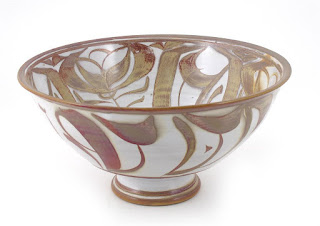Alfred trained as an architect, Louise as an embroiderer and a calligrapher. Alfred persuaded Wedgwood to revive the art of freehand painting on pottery, one of the most successful marriages of Arts and Crafts ideas with industrial manufacturing, lasting until the late 1930s. The Powells worked at Wedgwood's factory in Stoke-on-Trent and also had a small studio in London where blank Wedgwood pottery was sent for decoration.
Alfred Powell was invited by W.R.Lethaby to start a pottery painting class at the Central School of Arts and Crafts in 1906. He only led it for a couple of years and then handed it over to one of the young women in his London studio, Margaret Hindshaw. For twenty years Miss Hindshaw's students produced pottery decorated freehand like this sugar bowl, then her assistant, Dora Billington, acquired a high temperature kiln for the class, and it turned to the Anglo-Oriental style stoneware pottery that was coming into the art galleries under the influence of Bernard Leach and William Staite Murray.
The work designed by the Powells for Wedgwood (much of it decorated by themselves) was the last flowering of the "art pottery" that came out of the Arts and Crafts Movement. William Rothenstein, director of the Royal College of Art, considered the Powells to be the most outstanding pottery decorators of the age and wanted to bring them in to teach in his pottery department. The plan never came off and he became enamored of the bold, textured stonewares of Staite Murray and brought him in instead.
Surface decoration went out of fashion in studio pottery, though it was continued by unfashionable studio potters like those of the Bloomsbury Group, Venessa Bell (above), Duncan Grant and later Quentin Bell. Their making was clumsy and their mark-making lacked fluency, but their sense of design and colour was acute and the relationship between form and decoration on their pots was second to none. Quentin Bell went to the Central School to learn pottery in the 1930s, where he was taught to throw by Miss Billington.
Despite her admiration of the newly fashionable stonewares, Miss Billington continued to decorate with a long flexible brush and later encouraged Alan Caiger-Smith (above) to decorate in this way on white tin glaze. Caiger-Smith revived this tin glaze technique and over fifty years at his Aldermaston pottery trained dozens of young potters. One of them was Judith Partridge. I trained with Judith Partridge in the 1970s. So that's why I like this sugar bowl.




No comments :
Post a Comment